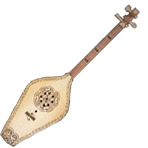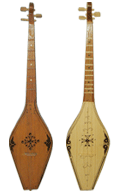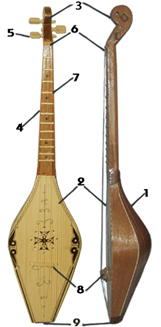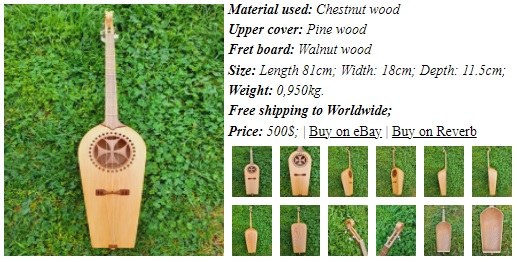:: Panduri

“Panduri” is a traditional Georgian three-string instrument widely spread in all regions of East Georgia: such as Pshavkhevsureti, Tusheti, Kakheti and Kartli. In general, Panduri is generally used as an accompaniment instrument (it accompanies one-part heroic, comic and love songs, but sometimes it is used in dances too). There are two kinds of this instrument in Georgia: one of them is “Panduri” itself and another is called “Chonguri”. But “Chonguri” as we will see below though looks like Panduri represents a completely different instrument.

Imeretian (West Georgia) Folk & Classic Panduri. The body is designed part by part, by attaching thin wooden plates together.
Once there existed two varieties of Panduri - 3 fret and 7 fret ones. In 1934 Kiril Vashakidze, a well-known art director in Georgia, after prolong and tensive work with mathematic calculations presented a more advanced version of panduri. He experimented with a folk 6-fret Panduri and by adding flat and sharp halftones to it, created Panduri prima and Panduri tenor with 12 frets. This innovation allowed Georgian musicians to use Panduri not only for accompaniment, but for performing solo parties of classical masterpieces in various combinations as well. Mr. Vashakidze has made a valuable contribution towards formation of Georgian National Musical Orchestra.
Panduri prima is tuned in such manner: “E” string - first, “C- flat” string - second, “A” string – third. There are twelve frets on the instrument’s neck with a two-octave range from “B-flat” to “C”. Panduri tenor is tuned the same way as a violin cello, with an exception of the fourth string: “A” string – first “D” string – second “G” string – third.
So, In general, three stringed Classic Panduri tuning is: from down E-C#-A
Two stringed Khevsuretian panduri tuning is: G-C1.
Three stringed Folk Panduri tuning is: from down C-A-G. Sometimes B-G-F.
Imeretian (West Georgia) Classic Panduri. The body is designed part by part, by attaching thin wooden plates together.
.
As was mentioned above there are two kinds of the discussed instrument in Georgia - Panduri and Chonguri. Though often being mixed up, these instruments differ
from each other. Panduri’s main parts are body, neck and subsidiaries. The body consists of an abdomen (1) and an upper board (2). The neck consists of a head (3) and a finger-board (4). The subsidiaries are tuners (5 "moqlons"), a nut (6 "kora"), frets (7), a bridge (8 "jora") and a button (9). As mentioned, Panduri has 3 nylon strings (lari, dzali, alka). The strings are equal in length and thickness.
In general rule, Panduri is cut out from the whole core of wood, also there is a different manner of designing this instrument, when the instrument body is glued part by part, by attaching thin wooden plates together.
Panduris from different regions of Georgia have different shapes. The body (abdomen) of a Khevsuretian Panduri is oar-shaped and massive, other Panduris have shapes of boats, ovals or are pearshaped. On the upper board are some holes(2). Khevsuretian Panduris have more holes than others. The neck’s head (3) is deflected backwards or has a sea-shell shape. It has 4 holes, three of which are for the tuners and one is for a strap to hang the instrument. The Panduris are made out of locally-growing trees. All parts of the Panduri are cut out of the same material. Only Khevsuretian Panduris have upper boards cut out of a different tree (pine or fir). The Panduri has three strings of the same length and thickness. Formerly, the strings were made of sheep or goat guts. The scale of each string is diatonic. The sound range of a Khevsuretian Panduri is a sixth and that of other Panduris is an octave on ninth. The tune of a Panduri is second-third. The 1st and 2nd strings give minor second, the 2nd and 3rd strings give major third.

Imeretian (West Georgia) Folk Panduri. Cut from whole core of wood.
In old times it was unimaginable for families in all regions of Georgia to be without a panduri. The instrument has long been considered a very valuable gift and were considered to be the best memorable present. It is kept in a highly visible place in a home. Besides, it was also possible to buy them… In Khevsureti (Eastern mountainous part of Georgia) the price of a well-made Panduri, for instance, equaled the price of a sheep or 5kg. of melted butter. But at that time these instruments were rarely made for commercial sale. Rather, An extra Panduri was not sold, but presented to someone. They were created as family heirlooms and given as heartfelt gifts. In each Georgian family this instrument was kept in a visible place (it was usually hung on the wall). It is easy to notice that in cloudy weather Panduri and Chonguri strings produce weak and suppressed sounds. These instruments are usually played by both men and women. Solo songs as well as heroical poems can be performed with their accompaniment. In past Panduri and Chonguri were often played during feasts, weddings or religious holidays.
In the eastern Georgia province of Kakheti, lullabies (the famous mother’s song called "Iavnana") are frequently accompanied by panduri music when the songs are directed to the protective spirits (known as "Batonebi") to help children sick with serious illnesses, such as German measles. We should note that the using Panduri by itself in the traditional ceremony related with the “Batonebi”’s worship evidently points to the instrument’s ancient origination.

Megrelian Chonguri & Classic Panduri.
Panduri and Chonguri were often used in religious holidays and rituals. They were important domestic items in every Georgian family. They were symbols of happiness and merriment. That is why these instruments were not played during the period of mourning. Moreover, when somebody died, Panduri or Chonguri was usually put out of sight in that family for a year. And as the time of mourning was over, the head of the family would take the instrument, strike the strings and sing a song as a symbolic end of the mourning period. Then he would pass the Panduri to the other members of the family and their relatives. Finally, the whole village was able to play and sing songs. This tradition called “opening Panduri” or opening merriment was widespread in the mountain regions of the East Georgia. If there was a religious holiday before the mourning period was over, or any family in the village was planning a wedding that would naturally be accompanied by merriment and singing, but could not afford doing it for the respect to relatives of the dead person, then the closest relative of the dead person would take the panduri and go out into the crowd to play (“open merriment”). Then he would offer the instrument to someone else to play. At first, other community members would refuse. Then after several requests were been made, someone would accept his offer and play. Thus, the merriment would be “open” for the villagers, but the relatives would continue mourning.
According to historical records of 10th century, certain instruments similar to Panduri and Chonguri can be found among some other nations: Armenians have got “Pandrini”, Persians - “Tanburi”, Ukranians - “Bandura”, Arabs - “Tonburi” and so on. The banjo, originally brought to the United States from Africa, is yet another instrument that shares a history with the chonguri and panduri.
The panduri and chonguri were also used as accompaniments to work. Shepherds often played these instruments (many ethnographic studies have been conducted on the role of the panduri in the lives of shepherds in Georgia). When a shepherd in the mountains had a strong feeling of happiness or sorrow and a wish for expressing it, he would reach for his panduri. This is reflected in many Khevsuretian poems: “I sat down and began to make up poems and play Panduri…” “I took you Panduri, sang a song about you!” A good panduri or chonguri player was greatly respected among the mountain inhabitants. No merriment would take place without him. That’s why these instruments of Georgian ancestors have been preserved up today.
Go to top
 “Panduri” is a traditional Georgian three-string instrument widely spread in all regions of East Georgia: such as Pshavkhevsureti, Tusheti, Kakheti and Kartli. In general, Panduri is generally used as an accompaniment instrument (it accompanies one-part heroic, comic and love songs, but sometimes it is used in dances too). There are two kinds of this instrument in Georgia: one of them is “Panduri” itself and another is called “Chonguri”. But “Chonguri” as we will see below though looks like Panduri represents a completely different instrument.
Once there existed two varieties of Panduri - 3 fret and 7 fret ones. In 1934 Kiril Vashakidze, a well-known art director in Georgia, after prolong and tensive work with mathematic calculations presented a more advanced version of panduri. He experimented with a folk 6-fret Panduri and by adding flat and sharp halftones to it, created Panduri prima and Panduri tenor with 12 frets. This innovation allowed Georgian musicians to use Panduri not only for accompaniment, but for performing solo parties of classical masterpieces in various combinations as well. Mr. Vashakidze has made a valuable contribution towards formation of Georgian National Musical Orchestra.
Panduri prima is tuned in such manner: “E” string - first, “C- flat” string - second, “A” string – third. There are twelve frets on the instrument’s neck with a two-octave range from “B-flat” to “C”. Panduri tenor is tuned the same way as a violin cello, with an exception of the fourth string: “A” string – first “D” string – second “G” string – third.
So, In general, three stringed Classic Panduri tuning is: from down E-C#-A
Two stringed Khevsuretian panduri tuning is: G-C1.
Three stringed Folk Panduri tuning is: from down C-A-G. Sometimes B-G-F.
“Panduri” is a traditional Georgian three-string instrument widely spread in all regions of East Georgia: such as Pshavkhevsureti, Tusheti, Kakheti and Kartli. In general, Panduri is generally used as an accompaniment instrument (it accompanies one-part heroic, comic and love songs, but sometimes it is used in dances too). There are two kinds of this instrument in Georgia: one of them is “Panduri” itself and another is called “Chonguri”. But “Chonguri” as we will see below though looks like Panduri represents a completely different instrument.
Once there existed two varieties of Panduri - 3 fret and 7 fret ones. In 1934 Kiril Vashakidze, a well-known art director in Georgia, after prolong and tensive work with mathematic calculations presented a more advanced version of panduri. He experimented with a folk 6-fret Panduri and by adding flat and sharp halftones to it, created Panduri prima and Panduri tenor with 12 frets. This innovation allowed Georgian musicians to use Panduri not only for accompaniment, but for performing solo parties of classical masterpieces in various combinations as well. Mr. Vashakidze has made a valuable contribution towards formation of Georgian National Musical Orchestra.
Panduri prima is tuned in such manner: “E” string - first, “C- flat” string - second, “A” string – third. There are twelve frets on the instrument’s neck with a two-octave range from “B-flat” to “C”. Panduri tenor is tuned the same way as a violin cello, with an exception of the fourth string: “A” string – first “D” string – second “G” string – third.
So, In general, three stringed Classic Panduri tuning is: from down E-C#-A
Two stringed Khevsuretian panduri tuning is: G-C1.
Three stringed Folk Panduri tuning is: from down C-A-G. Sometimes B-G-F.

 “Panduri” is a traditional Georgian three-string instrument widely spread in all regions of East Georgia: such as Pshavkhevsureti, Tusheti, Kakheti and Kartli. In general, Panduri is generally used as an accompaniment instrument (it accompanies one-part heroic, comic and love songs, but sometimes it is used in dances too). There are two kinds of this instrument in Georgia: one of them is “Panduri” itself and another is called “Chonguri”. But “Chonguri” as we will see below though looks like Panduri represents a completely different instrument.
Once there existed two varieties of Panduri - 3 fret and 7 fret ones. In 1934 Kiril Vashakidze, a well-known art director in Georgia, after prolong and tensive work with mathematic calculations presented a more advanced version of panduri. He experimented with a folk 6-fret Panduri and by adding flat and sharp halftones to it, created Panduri prima and Panduri tenor with 12 frets. This innovation allowed Georgian musicians to use Panduri not only for accompaniment, but for performing solo parties of classical masterpieces in various combinations as well. Mr. Vashakidze has made a valuable contribution towards formation of Georgian National Musical Orchestra.
Panduri prima is tuned in such manner: “E” string - first, “C- flat” string - second, “A” string – third. There are twelve frets on the instrument’s neck with a two-octave range from “B-flat” to “C”. Panduri tenor is tuned the same way as a violin cello, with an exception of the fourth string: “A” string – first “D” string – second “G” string – third.
So, In general, three stringed Classic Panduri tuning is: from down E-C#-A
Two stringed Khevsuretian panduri tuning is: G-C1.
Three stringed Folk Panduri tuning is: from down C-A-G. Sometimes B-G-F.
“Panduri” is a traditional Georgian three-string instrument widely spread in all regions of East Georgia: such as Pshavkhevsureti, Tusheti, Kakheti and Kartli. In general, Panduri is generally used as an accompaniment instrument (it accompanies one-part heroic, comic and love songs, but sometimes it is used in dances too). There are two kinds of this instrument in Georgia: one of them is “Panduri” itself and another is called “Chonguri”. But “Chonguri” as we will see below though looks like Panduri represents a completely different instrument.
Once there existed two varieties of Panduri - 3 fret and 7 fret ones. In 1934 Kiril Vashakidze, a well-known art director in Georgia, after prolong and tensive work with mathematic calculations presented a more advanced version of panduri. He experimented with a folk 6-fret Panduri and by adding flat and sharp halftones to it, created Panduri prima and Panduri tenor with 12 frets. This innovation allowed Georgian musicians to use Panduri not only for accompaniment, but for performing solo parties of classical masterpieces in various combinations as well. Mr. Vashakidze has made a valuable contribution towards formation of Georgian National Musical Orchestra.
Panduri prima is tuned in such manner: “E” string - first, “C- flat” string - second, “A” string – third. There are twelve frets on the instrument’s neck with a two-octave range from “B-flat” to “C”. Panduri tenor is tuned the same way as a violin cello, with an exception of the fourth string: “A” string – first “D” string – second “G” string – third.
So, In general, three stringed Classic Panduri tuning is: from down E-C#-A
Two stringed Khevsuretian panduri tuning is: G-C1.
Three stringed Folk Panduri tuning is: from down C-A-G. Sometimes B-G-F.




